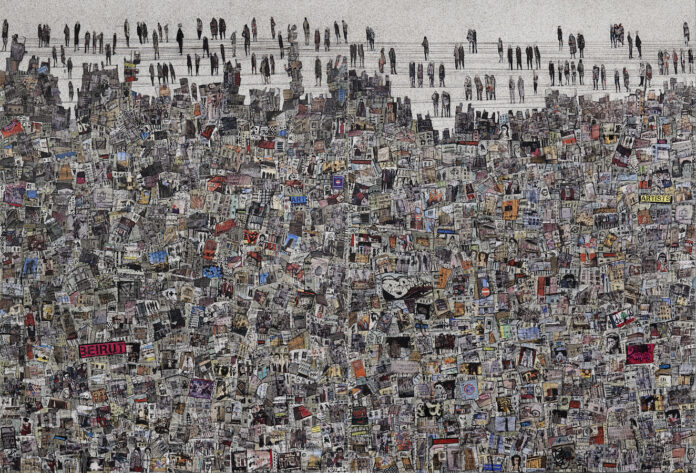DUBAI: The Insitut du Monde Arabe in Paris is one of Europe’s most important repositories of Arab art and culture. In its latest exhibition, “Lights of Lebanon,” the institute “celebrates the prodigious creativity of modern and contemporary artists from Lebanon and its diasporas.”
The exhibition is split into three periods, running in reverse chronological order: 2005 to the present day (“Lebanon, a country of never-ending reconstructions”), 1975-2005 (“The somber years”), and 1943 to 1975 (“The Golden Age”).
“What has always been the strength of the Lebanese … is that the fragility of their state never stopped them from moving forward, from building, even if they lived in constant risk. In short, they live in the present, without obscuring personal and collective memory,” the IMA’s museum curator Eric Delpont says in the show catalogue. “It seems to me that in the West, especially in Europe, we couldn’t do this, because we need a sense of security.”
Many of the works on display were donated by the prolific collectors of Arab art Claude and France Lemand. It was Claude who came up with the title of the show, explaining that he sees artists as the “Lights of Lebanon.”
“I mean above all those who have made Beirut the city of light of the East, who have shone at all times of its tormented history, even if over the decades, the dominant clans — who defend only their interests — have plunged Lebanon into political, economic, financial, social, health and even cultural chaos,” he says in the catalogue. “But Lebanon remains a country from which the light shines.”
Here, Arab News presents some highlights from the exhibition, which Lemand describes as just “just a drop in the ocean, as far as this devastated country is concerned, but at least we have the satisfaction of having motivated and even inspired many artists, of all generations.”
Zena Assi
‘Holding On By A Thread’
Assi is one of several artists from the diaspora featured in the exhibition. Claude Lemand felt it important to stress that the show was dedicated to “all those who have links with the country” and believes the fact that the diaspora is so widespread shows that “Lebanon is not just Lebanon; it goes far beyond the small country and its small population and it echoes throughout the world.”
Assi is a multidisciplinary artist currently based in London. This incredibly detailed 2012 piece is typical of her works, which — the exhibition brochure explains — are “punctuated with visual references to eastern cities, particularly Beirut, and the difficulties endured by migrants from different backgrounds – anonymous tightrope walkers clinging onto life by a thread. Her fragmented cities reflect the migratory and urban violence, and the violence in Beirut. Bundles of memories, identity-based burdens, and emotional baggage, she describes their wanderings in cities that are represented as a kaleidoscope of symbols and codes: graffiti on the walls, billboards, contemporary souks, and luxury goods.”
Shaffic Abboud
‘Cinema Christine’
Abboud is widely regarded as one of the — if not the — most important modern Lebanese artists. He is best known for his paintings, several of which feature in the “Lights of Lebanon” exhibition, and particularly for his richly textured abstract works, but this piece is something of a curio. It was created in 1964 for his daughter Christine and was inspired by the picture boxes of itinerant storytellers who would travel from village to village, enthralling the children. “Cinema Christine” is a working model of such a box, complete with magic lamp and narrative scrolls.
Ayman Baalbaki
‘The End’
Baalbaki’s bleak dystopian image was selected to open the show — presumably a deliberate statement that Lebanon has now reached rock bottom (perhaps tempered with the hope that, from such a point, the only way is up). The artist has spent much of his career exploring the numerous conflicts in the region through his art — his images of veiled fighters have proved particularly popular. This piece, created over the last five years, is less confrontational but equally powerful.
Etel Adnan
‘Al-Sayyab, The Lost Mother and Child’
The much-revered artist, writer and poet is still prolific today, aged 96, and is widely regarded as Lebanon’s greatest female artist. She is best known for her colorful impressionist landscapes, but has described her artist books (or ‘leporellos’) such as this one as “particularly important” parts of her portfolio. In the leporellos, inspired by Japanese folding books, Adnan complements her writing with drawings in ink and watercolor. “I avoided using traditional calligraphy, although it is wonderful, to highlight my personal writing, which, in its very imperfection, brings the person writing into the work,” she states in the show catalogue, which goes on to explain that Adnan uses the horizontal, foldable format to “create works that can be extended into space — ‘a liberation of the text and images.'”
Fatima El-Hajj
‘Promenade’
El-Hajj’s work is displayed in the second part of the exhibition (“The somber age”), but — as Claude Lemand explains in the catalogue — her vibrant work can be seen as defiance in the face of the violence and destruction that surrounded her as she began her artistic career around the time that the Civil War broke out in the mid-Seventies. “She experienced the entire civil war and all the wars and misfortunes that followed; she still suffers in body and soul, but she has never painted war scenes or scenes of destruction,” he says. “For her, painting is eternal; she’s developed thinking and a world that transcends war and death.”

